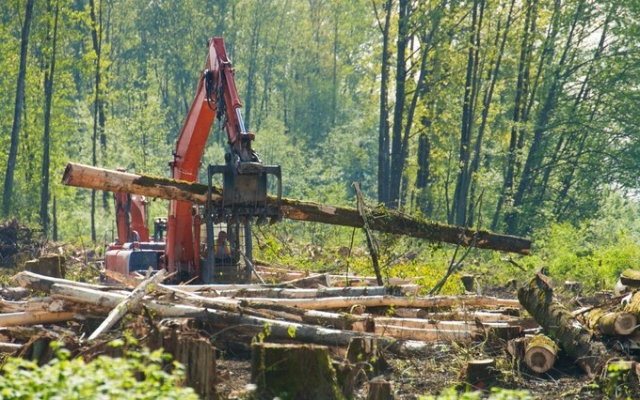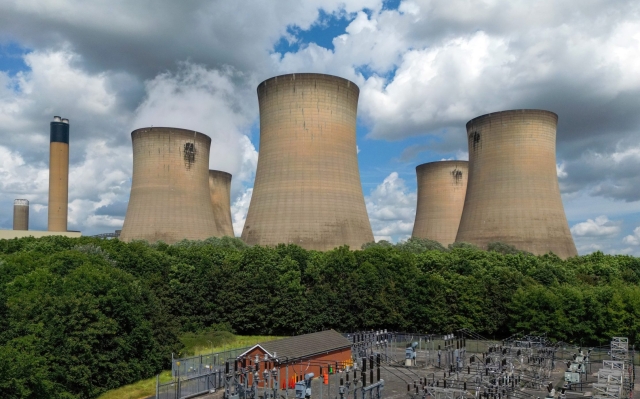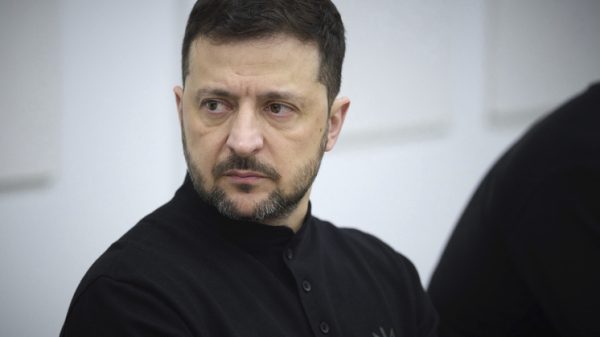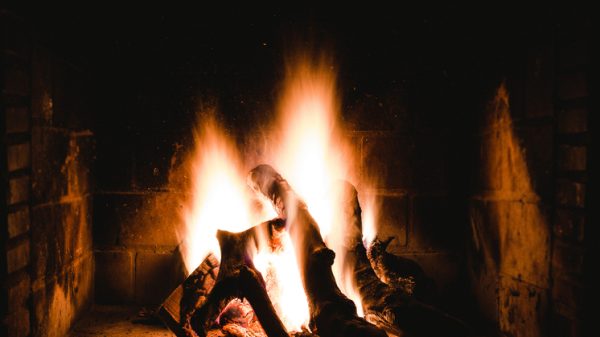 The US and Canada are the main suppliers of timber for use at Drax's power station in Yorkshire. Photo: Cavan Images/Alamy Stock Photo
The US and Canada are the main suppliers of timber for use at Drax's power station in Yorkshire. Photo: Cavan Images/Alamy Stock Photo
Wood, a fuel that British industry thought it had left behind more than a century ago, is making a comeback.
Driven by the revival is the Drax Group, owner of the controversial Drax power station, which recently posted a 10-fold increase in its latest annual profit.
Its Yorkshire plant, Britain's largest and most controversial power station, produced about 6% of the country's electricity in 2023 by burning 6.4 million tonnes of wood. For context, that's the equivalent of 27 million trees.
The idea of a Britain powered partly by wood may seem shocking to some, but for Drax it forms the basis of a sustainable and renewable future.
For many years, Drax has invested in tree-powered electricity, which the company calls a key source of environmental clean energy, and now its bosses are planning to go further.
Announcing on Thursday that pre-tax profits would reach £796 million in 2023, up from £78 million a year earlier, chief executive Will Gardiner said he wanted to build more wood-fired power stations, primarily in the US.
These power stations will be supported by new wood pellet plants, allowing Drax to double production to eight million tonnes by 2030.
This means Drax will supply wood-fired power stations at around the world, not just in Yorkshire.
For Mr Gardiner, who was appointed chief executive of Drax in 2018, the latest profit growth vindicates his company's strategy.
“We remain the largest supplier of renewable energy by volume in the UK,” he told investors.
“We have built a business that plays an important role in supporting energy security by providing dispatchability. , renewable energy for millions of homes and businesses, especially during periods of peak demand when wind and solar are weak.”
Others disagree. Environmentalists say cutting down forests to produce electricity destroys the environment rather than protects it. This view is supported by some senior politicians.
Leading Conservative MP Sir Peter Bottomley, the father of the House of Commons, yesterday wrote to Prime Minister Rishi Sunak demanding Drax be closed.
“Burning trees in the UK is not a justifiable way to prevent climate change,” he said. “The Drax power station burns 27 million trees a year. There are only 46 million trees in our New Forest.
“The wood that Drax burns is imported, mainly from North America, on diesel-powered cargo ships. And setting trees from North America on fire here is an expensive pleasure.”
Sir Peter's reference to cost refers to the taxpayer subsidies Drax receives for clean energy production, which amounted to £617 million in 2022 and £587 million in 2023.< /p>
The Drax plant has a long and varied history history. The facility was originally built as a coal-fired power station in the 1960s and was operated by the now-defunct Central Electricity Authority.
After expanding in the 1980s to produce four gigawatts of electricity, enough to power several million homes, Drax became the largest coal-fired power station in Western Europe.
However, almost from the outset it raised concerns about environment. and electricity.
Much of the initial research focused on sulfur and other emissions associated with acid rain.
By the 2000s, concerns had grown into wider issues around climate change, prompting the UK to close its coal-fired power stations.
However, Drax took a different path, announcing in 2012 that he would retool four of the six power units to burn biomass.
By 2018 the conversion was complete and the coal was gone, resulting in what its owners claimed was the UK's largest renewable power station.
 In 2023, Drax produced around 6% of the UK's electricity by burning 6.4 million tonnes of wood. Photo: Christopher Furlong/Getty Images
In 2023, Drax produced around 6% of the UK's electricity by burning 6.4 million tonnes of wood. Photo: Christopher Furlong/Getty Images
Despite this, controversy remains over Drax's green energy due to its reliance on wood. Questions often arise about where it comes from.
Last year alone, Drax imported 4.6 million tons of wood from the United States and another 760,000 tons from Canada, as well as supplies from Brazil, Latvia and Russia.< /p> p>
Its dependence on North American timber has led Drax to move forward with plans to build 18 new logging mills across the country, which would increase production to eight million tons a year.
The forests Drax burns, Mr. Gardiner said, , These are not just ecosystems, but a source of fuel for the future, as well as ideal locations for new power plants.
Criticism of Drax's activities will not come as a surprise to the CEO, but he is now deploying new defenses as he says Drax's operations are essential to the UK's energy security.
He notes that the energy produced by Drax is essential to the fight with disruptions to other renewable energy sources such as wind and solar.
Drax's latest annual report makes this clear: “The UK plans to reach net zero by 2050. will require the electrification of sectors such as heating and transport, which will lead to a significant increase in electricity demand.
“We believe that intermittent, renewable and inflexible, low-carbon energy sources – wind, solar and nuclear – can help meet this demand. However, this will only be possible if other energy sources can provide the power needed to ensure security of supply.”
It is these «other energy sources» that Drax wants to consider, as the company is among the leading power producers that benefit from lucrative government subsidies.
Tatepayer support also recently led to Drax receiving approval from the Minister energy engineer Claire Coutinho for the installation of two carbon dioxide capture units to the Drax generating units.
The idea behind a carbon capture scheme is that the trees they grow absorb carbon dioxide from the air through photosynthesis.
If this CO2 is then captured by burning the trees and burying them permanently under the North Sea, as Drax suggests, , then this process completely removes CO2 from the atmosphere.
Drax believes this “carbon-negative” strategy can save him from criticism, but it has one more battle to win.
It revolves around the company's subsidies, which expire in 2027 but are critical to the plant's viability.
Up until last fall, it looked like the company would lose that battle, but Drax has gained momentum amid Britain's push to increase production volumes. domestic energy supplies.
Even so, Gardiner is adamant that burning trees will be a critical tool in saving the planet, potentially even helping the forests that Drax is responsible for cutting down.
“Our the ambition is to remove 20 million tonnes of CO2,” he says. “We believe that our activities will help preserve more working forests.”






















































Свежие комментарии